Can You Use Sports Tape on Lower Back
Taping for Low Back Pain
Taping for Low Back Pain 2019-10-17 2019-12-09 http://www.pogophysio.com.au/wp-content/uploads/pogo-physio-with-a-finish-line2x.png POGO Physio Gold Coast https://www.pogophysio.com.au/wp-content/uploads/taping-for-low-back-pain.jpg 200px 200px

Low back pain is the most common presentation to medical practitioners (6). It is believed that 60-80% of adults will experience back pain at least once in their life – with 10-20% of these becoming chronic (6). To address this burden upon society, researchers across the world investigate the most effective way or ways to improve those experiencing low back pain. Using the latest clinical evidence, the most effective way to treat these presentations are via:
- Settling down the inflammation and symptoms
- Modifying loads (load vs capacity mismatch)
- Educating on ideal postures and positions to avoid (spinal hygiene)
- Improving capacity (strengthening, sleep, nutrition, psychological factors)
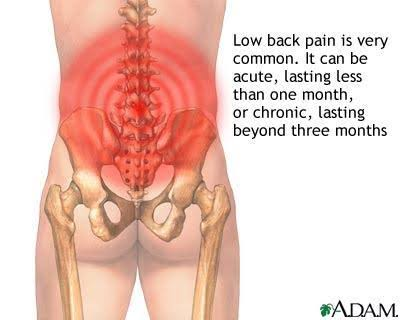
However, during these steps, clinicians will often look to other modalities to gain some advantage for their client to achieve positive outcomes. These modalities include, but are not limited to, massage, manual therapy, neural mobilisations, EPA modalities (TENS, U/S) and taping.
This blog will investigate the clinical significance of using tape to positively influence a client's low back pain.
Despite discogenic low back pain (DLBP) and disc herniations (seen in image below) being the most common types of low back pain (69% of low back pain episodes are caused by a disc-related pathology) it is important to note the vast majority of literature on tape's effectiveness used a sample size of "chronic low back pain" (8). This differential must be considered when applying or not applying their findings to a client with an acute episode of low back pain. 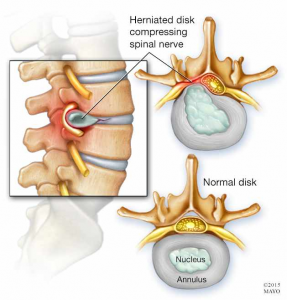
Kinesio Taping
Kinesio tape originated from Japan in the 1970s by Dr. Kenso Kase (6). Kinesio tape (K -tape, rocktape) is well known in the physiotherapeutic world and has clinical significance in areas such as pain, swelling, scar healing, increasing proprioception and relaxing muscles (6). Kinesio tape can stretch from 120-140% of its original size with researchers claiming this stretch can either inhibit or excite muscle activation depending upon its application and the muscle fibre direction (6). The study was also effective at preventing gains in body mass despite partaking in 2 strength sessions per week. This was achieved via the training protocols mentioned earlier (4 sets of 6RM) that prevents muscle hypertrophy (4). This therefore prevented the reduction in mitochondrial density and oxidative enzyme activity – negative effects related to gains in body mass (4).

What the literature tells us
Effects on Pain
Various studies have shown a short-term (3 weeks) lower back pain when using KT (7). A study in 2019 had results that showed immediate effects of KT on pain and postural stability of clients with CLBP (7). A further study further supports this finding as they investigated 3 taping techniques for clients with LBP and no neurological deficit. The KT group achieved greater pain relief than the use of rigid tape or placebo (sham tape) (7). Another study showed pain relief via lumbar KT for pregnancy-related low back pain had greater short term (5 days) effects than paracetamol usage (7).
Effects on Posture
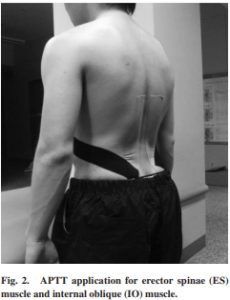
Multiple studies have shown that clients with LBP have worse postural control (in relation to the pelvis and lumbar spine) when compared to healthy subjects (1). It has been argued that this deficit can be due to a lack of or altered proprioceptive input as well as a muscular imbalance between the trunk flexors and extensors (1). Researchers believe that these deficits can be improved through the use of KT via its ability to stimulate the nervous and cutaneous (skin) systems to increase proprioceptive feedback (1). KT can also improve function of the erector spinae and gluteus medius muscles which facilitate a more ideal pelvic and lumbar spine position (1). The stretch of the skin underneath the KT may also inhibit the transmission of pain signals from the previously painful stimuli which can thus improve the client's postural control further as they are no longer guarding the painful structure (1). KT appears to decrease the time a muscle takes to reach failure – suggesting that it has an influence on muscle fatigue and hypothesising that its use can be beneficial for those lacking certain postural muscle endurance (1).
Clinically, it is known that prolonged postures (where the pelvis is posteriorly tilted) such as "slump" sitting is associated with loading of the intervertebral discs and connective tissue, causes backward movement of the discs' fluid and reduces activation of spinal stabilising muscles (4). Mechanics such as this can cause an onset or aggravation of low back pain (4).
A study in 2011 trialled the effects of KT on pelvic posture before, during and after 30 minutes of slump sitting (4). The tape was applied to increase anterior pelvic tilt to reduce loading of the IV discs. They found that all subjects showed a significant increase in anterior pelvic tilt immediately after the application of the KT with the increase maintaining when standing up after 30 minutes of slump sitting (4). See figure 2 for the application of the KT.
As such, they concluded that KT's use to increase anterior pelvic tilt can be used as an adjunct treatment method for preventing posterior pelvic tilting in prolonged positions such as slump sitting (seen in image B below)(4). 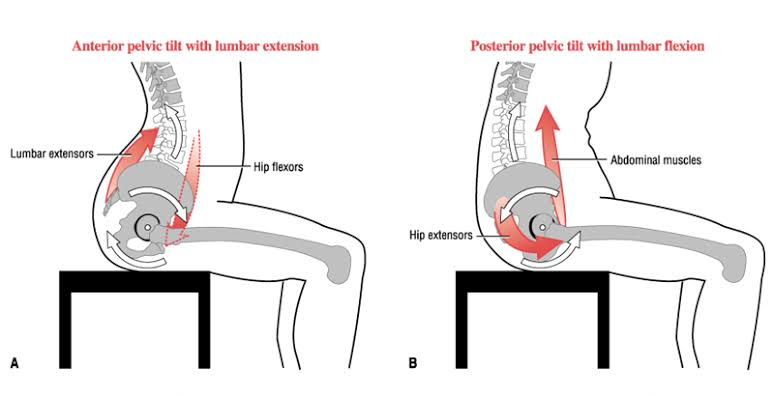
Effects on "Non-Specific Chronic Low Back Pain"
A trial in 2012 used KT according to the Kenzo Kase recommendations for low back pain. It showed that those with "non-specific chronic low back pain (NS-CLBP)" experienced statistically significant improvements in pain, disability and trunk muscle endurance (3). However, the effects were only small and the improvements were observed up until the four week follow-up (3). Due to the diagnosis of those included within the study, and recent research supporting the biopsychosocial factors of "NS-CLBP", the tape's short term effects may have been influenced by placebo (3).
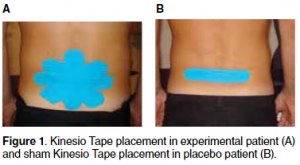
Medium Term Effects
Another study wanted to investigate the "medium term" effects of taping for LBP clients. Researchers in this study analysed the effects of KT application twice a week for four weeks and compared the results with "sham taping" 6 months post treatment (2). They concluded that there was no statistical difference between the groups at the 6 month follow-up (2).
Summary of the literature
Numerous systematic reviews have shown that, with respect to pain and disability outcomes, kinesio taping does appear to have a small analgesic effect and may reduce disability (6). However, it is important to note that the effects are not superior to any other treatment and the clinical significance of its use remains unclear (6)
So should I use tape or not?
I believe that KT may have a role to play in improving the short term outcomes (up to 4 weeks) of those that present with discogenic low back pain. However, its use could be argued to only be clinically useful when the client's pelvic posture is influencing their back pain or have sedentary occupations. It is also important to note that it cannot be used in isolation and must be accompanied with the correct education, reassurance, anti-inflammation advice, manual therapy and exercises to improve their capacity.
Which taping method is best for the lower back?
In my opinion, and in relation to the research, the most beneficial taping method to influence LBP when posture is affecting their symptoms is by facilitating the erector spinae and internal obliques – as seen in figure 2.


Alec Lablache POGO Physiotherapist
Featured in the Top 50 Physical Therapy Blog
References
- Abbasi, S., Rojhani-Shirazi, Z., Shokri, E., & García-Muro San José, F. (2018). The effect of kinesio taping on postural control in subjects with non-specific chronic low back pain. Journal of Bodywork & Movement Therapies, 22(2), 487-492. doi:10.1016/j.jbmt.2017.06.003
- Araujo, A. C., do Carmo Silva Parreira, Patrícia, Junior, L. C. H., da Silva, T. M., da Luz Junior…Pena Costa, L. O. (2018). Medium term effects of kinesio taping in patients with chronic non-specific low back pain: A randomized controlled trial. Physiotherapy, 104(1), 149-151. doi:10.1016/j.physio.2016.12.001
- Castro-Sánchez, A. M., Lara-Palomo, I. C., Matarán- Peñarrocha, G. A., Fernández-Sánchez, M., Sánchez-Labraca, N., & Arroyo-Morales, M. (2012). Kinesio taping reduces disability and pain slightly in chronic non-specific low back pain: A randomised trial. Journal of Physiotherapy, 58(2), 89-95. doi:10.1016/S1836-9553(12)70088-7
- Lee, J., & Yoo, W. (2011). The mechanical effect of anterior pelvic tilt taping on slump sitting by seated workers. Industrial Health, 49(4), 403-409. doi:10.2486/indhealth.MS1230
- Macedo, L. d. B., Richards, J., Borges, D. T., Melo, S. A., & Brasileiro, J. S. (2019). Kinesio taping reduces pain and improves disability in low back pain patients: A randomised controlled trial. Physiotherapy, 105(1), 65-75. doi:10.1016/j.physio.2018.07.005
- Nelson, N. L. (2016). Kinesio taping for chronic low back pain: A systematic review. Journal of Bodywork & Movement Therapies, 20(3), 672-681. doi:10.1016/j.jbmt.2016.04.018
- Toprak Celenay, S., & Ozer Kaya, D. (2019). Immediate effects of kinesio taping on pain and postural stability in patients with chronic low back pain. Journal of Bodywork & Movement Therapies, 23(1), 206-210. doi:10.1016/j.jbmt.2017.12.010
- Zhang, Y., Guo, T., Guo, X., & Wu, S. (2010). Correction: Clinical diagnosis for discogenic low back pain. International Journal of Biological Sciences, 6(6), 613-613. doi:10.7150/ijbs.6.613

You have Successfully Subscribed!
Recommended Posts
Can You Use Sports Tape on Lower Back
Source: https://www.pogophysio.com.au/blog/taping-for-low-back-pain/
0 Response to "Can You Use Sports Tape on Lower Back"
Post a Comment